

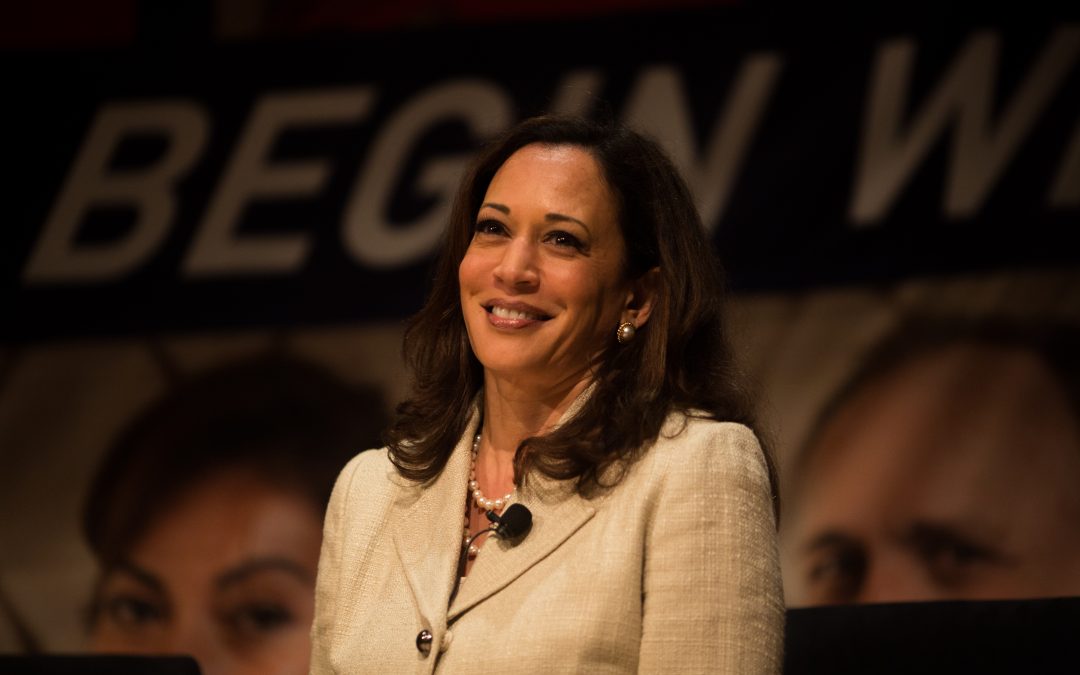
Kamala Harris helps get millions for HBCUs

California Democratic Senator Kamala Harris knows that higher learning at the nation’s historically Black colleges and universities requires higher funding. Harris has been a longtime advocate for HBCUs, helping to push through a funding increase that would put millions into these schools.
A 14 percent increase in federal funding was included in the Senate’s omnibus spending bill, elevating the amount for HBCUs from $244.7 million in fiscal year 2017 to $279.6 million in fiscal year 2018, the LA Sentinel reported Wednesday.
“HBCUs are critical to the foundation of our higher education system, and provide opportunities for some of the nation’s most promising and deserving students”, Harris, an HBCU alumnus of Howard University, said. “I am pleased funds in this bipartisan budget agreement will be invested in the future of these young people. Ensuring HBCUs have the federal support and resources they need to thrive for generations to come is one of my top priorities as a proud HBCU graduate.”
As part of the Senate bill, historically Black graduate institutions will also receive a 14-percent funding increase, from $63.3 million to $72.3 million. Also, other majority-Black institutions will receive a raise from $9.9 million to $11.4 million. Bag secured!
Harris, along with Alabama Democratic Senator Doug Jones, requested the HBCU funding increase in a letter to the Senate Appropriations Subcommittee on Labor, Health and Human Services, Education, and Related Agencies. Twelve of their Senate colleagues supported their letter, according to the Sentinel.
HBCU presidents and other officials have been fighting for more funding to keep the doors open to their campuses. Several historically Black colleges and universities have had to operate under the threats of low funding, decrease enrollment, lacking academic programs and even closure. Therefore, the funding increase spurred by Harris and other senators is a great step forward for helping HBCUs.
These schools also contribute billions to states through their economic impact and by helping to generate jobs, two more reasons for the government to keep HBCUs strong.
The post Kamala Harris helps get millions for HBCUs appeared first on DefenderNetwork.com.

COMMENTARY: Whites comprise nation’s highest number of teachers
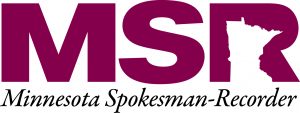
I spent most of my first year of grad school sitting in the back row of class with my hood up. There were nearly 40 of us in the cohort. Two were Black.
My hoodie was an act of silent dissent. Today, I completely understand when my students want to do the same, even with me in front of the room. Academia and public schools are spaces where people of color often feel underrepresented, unwelcome and unheard.
From third grade through high school, I was a student in a series of neighborhood public schools. Afterward, I went to community college and then on to a public liberal arts college where I earned my bachelor’s and eventually my master’s degree. Each phase of my educational journey shared two characteristics:
- The further I progressed, the fewer Black and Brown classmates I had.
- As I progressed, regardless of the demographics of the student population, the faculty and administrators were uniformly nearly all White.
That needs to change.
An organization I am part of, the National Network of State Teachers of the Year, recently released videos designed to provoke conversations that will lead to this kind of change. Called Courageous Conversations About Race in Schools, the videos provide an effective starting point for real discussions that should be happening in schools — particularly in colleges and universities across this country.
Research tells us that upwards of 80 percent of U.S. teachers are White. Different research tells us that nearly 80 percent of teachers are female. Obviously, those Venn diagrams overlap in a largely White and female workforce.
At the same time, because of higher birth rates among immigrant populations and the “mysterious phenomenon” of disproportionately high numbers of White children in private schools, a majority of the population of students in public school are students of color, and those numbers are headed even higher, based on enrollment numbers in lower grades.
Schools systems need to do a better job of attracting and retaining effective teachers of color. Students of color need to see more people of color in positions of expertise and authority, and teachers need to be conversant and literate in the cultural traditions that are present in their classrooms. None of these statements should be controversial.
The lack of representation is an equity issue, and to resolve it we can look to lessons elsewhere in our society. During the Vietnam War, the Pentagon realized that majority Brown platoons of soldiers and Marines wouldn’t take life-or-death orders from a uniformly White officer corps. The Pentagon thus underwent an intentional effort to diversify the officer corps. Since then, the Pentagon has submitted amicus curiae briefs in every major affirmative action case before the U.S. Supreme Court because they understand that representation matters.
Time for a representation disruption
The word “disruption” gets hurled around frequently in business and increasingly in education. Usually, it’s about handing Silicon Valley tech bros a metric ton of venture capital to sprinkle the #EdTech fairy dust of the moment. But I’m going to argue that when it comes to teacher diversity and representation in schools, we actually need disruption.
fairy dust of the moment. But I’m going to argue that when it comes to teacher diversity and representation in schools, we actually need disruption.
In my neck of the woods, the numbers are especially grim: There are only about 800 Black teachers in all of Washington State. In my 12-year teaching career, I have never worked with another Black male general education teacher.
There’s no reason for me to be alone. We see talented students of color all over higher education because universities know how to recruit them. As Jeff Duncan-Andrade says, “Look at any college football or basketball team and tell me colleges don’t know how to recruit Black talent. When I was a kid I thought Georgetown was an HBCU.”
But it can’t just be student-athletes. We need to bring in students who can increase teacher diversity. It’s imperative-and it’s well within our power.
Nate Bowling is a high school government teacher in Tacoma, Washington, who was named the 2016 Washington State Teacher of the year and a finalist for National Teacher of the Year.

MAKING A DIFFERENCE: 826LA helps local student writers become published

LOS ANGELES — Not many 6 to 18 year olds can can say they’ve been published.
But there are more than 300 in Los Angeles that can can claim the title of published writer thanks to 826LA.
Since 2005, the nonprofit has supported students throughout the Los Angeles Unified School District and around the country, helping them build confidence as creative and expository writers.
“At the heart of what we do is bring volunteers to work with students one-on-one,” said Marisa Urrutia Gedney, director of in-schools programs and college access. In many under-resourced and overpopulated classrooms, she said, it’s difficult for teachers to give their students personal attention, especially when it comes to their writing.
“Writing is difficult for anyone of any age, and we tell the students that. It takes a certain level of confidence to take what’s in your heart and in your head and write it down,” she said.
The intimate support “really helps students share their ideas so they have more confidence after they finish a writing assignment.”
Through its numerous free programs, more than 9,000 economically disadvantaged students in L.A. are taught how to write everything from poems, chapbooks and short films to stories, magazines and comic books during its weekend workshops.
During the week, students can take advantage of after-school and evening tutoring at two of 826LA’s writing locations in Echo Park and Mar Vista. There, volunteers help students with writing, reading and homework in all subjects.
“Our volunteers also go to schools where they work with teachers directly in the classrooms,” Gedney said. Because it’s not always possible for students to take a field trip to one of 826LA’s sites, volunteers drop into classrooms to support teachers with projects and provide students more one-on-one attention for writing assignments.
As for the many high school students working on their college applications, volunteers offer them help with their personal statements. This college-readiness work, Gedney said, is critical to what the nonprofit does.
“Personal statements help students write about their triumphs and trials,” she said. While students’ college applications show their academic successes, they don’t offer a glimpse into the realities of their lives.
By guiding them through their essays, they’re making “college writing more equitable.”
In 2013, the organization decided to extend this idea of equitability to South L.A., where they opened the Writers Room at Manual Arts High School.
There, students have a creative space where they can explore their writing voices and get college access support. It now serves more than 700 students every year and, as a result of this added support, more seniors are getting accepted into four-year schools.
As the nonprofit steadily grows, so has students’ enthusiasm for writing.
“So many times, once we publish a book of student writing, kids often say they want to be a writer. They say they want to be keep writing and get published,” Gedney said.
Kids frequently carry their published writing in their backpacks all year and show their teachers and classmates the work they’re so proud of, she added.
And this zest for writing that 826LA sees in its students is an energy it hopes to expand to more kids.
“Our hope is to increase capacity and bring in more volunteers into all our programs and centers to support more than 9,000 students a year,” Gedney said.
“We are always excited when people take interest in the work we do because it’s rewarding, exciting and fun.”
INFORMATION BOX
Executive Director: Joel Arquillos
Years in operation: 13
Number of employees: about 24
Annual budget: $1,744,809
Location: 1714 W. Sunset Blvd., Los Angeles, 90026

Oakland Students Head to D.C. for “March for Our Lives” Demonstration

A group of nine young leaders from East Bay schools, organized and led by Regina Jackson of East Oakland Youth Development Center (EOYDC), will participate in the “March for Our Lives” demonstration for an end to gun violence Saturday in Washington, D.C.
Congresswoman Barbara Lee urged Jackson to organize the delegation so that Oakland would have a presence in the historic march. Lee contributed money to pay for part of the trip, and a micro-grant covered the rest.
“Recently we did a listening session with Oakland Lee about gun violence. She asked me to coordinate the student delegation. I will be leading the group of students, who have all been affected by gun violence, ages 13-18,” said Jackson.
Members of the EOYDC delegation: Damoni Nears, senior at Moreau Catholic High; Destiny Shabazz, senior at McClymonds High; Devlynn Nolan, senior at Castlemont High; Jada White, 8th grader at Edna Brewer Middle; Khali Walker, freshman at Castlemont High; Kia Hanson, senior at Fremont High; Nala Lazimba, 8th grader at Alliance Academy; Rasheem Haskins, sophomore at Skyline High; and Ramaj Walker, junior at Envision Academy.
Organizers of the Washington D.C. march are students from Stoneman Douglas High School in Parkland, Florida, where 17 students and adults died.
The young Oakland leaders spoke about how gun violence has impacted their lives.
“I have first-hand experience with gun violence,” said Jada White, aged 13.
“I lost my father when I was just a baby. I am going to the march to share my experience and my hope for stronger gun education and policy.”
Seventeen-year-old Kia Hanson said, “I lost my brother to gun violence. My pain is real every day. I am going to the march to represent him and my hope that no one ever have to experience a tragedy like mine ever again.”
The young people plan to write a blog about the march after they return draft some language for bills to be considered at the state and federal level.
Over 800 rallies and marches are scheduled across the country Saturday in solidarity with the protest in Washington, D.C. In the Bay Areas, marches are planned for San Jose and San Francisco.
A rally will be held Saturday morning at 10 a.m. in front of City Hall in Oakland, and then attendees will go by BART to join forces with marchers in San Francisco.
The post Oakland Students Head to D.C. for “March for Our Lives” Demonstration appeared first on Oakland Post.
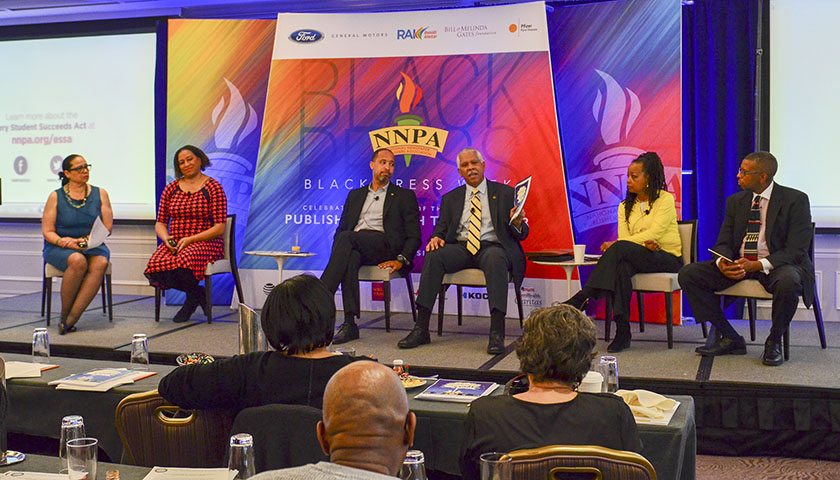
Parents, Black Publishers Discuss Excellence in Public Education During Black Press Week

Educators and education experts discussed parental engagement, equity in education and teacher diversity, during a special breakfast session for the NNPA’s Every Student Succeeds Act (ESSA) Public Awareness Campaign in Washington, D.C.
The session took place during the National Newspaper Publishers Association’s (NNPA) Black Press Week, an annual celebration of the relevance and lasting legacy of Black publishers.
Panelists included Washington Informer Publisher Denise Rolark Barnes; DNA Educational Solutions and Support CEO Dr. Robert L. Kirton Jr.; NAACP Washington Bureau Chief Hilary O. Shelton; Prince George’s County School Board Member Curtis Valentine; and Dr. Lannette Woodruff, an ESSA (Every Student Succeeds Act) taskforce member for the Office of the State Superintendent of Education in Washington, D.C.
Dr. Elizabeth Primas, the project manager for the NNPA’s ESSA Public Awareness Campaign, served as moderator for the session titled, “Striving for African American Excellence in Public Education: The Role of the Black Press” at the Dupont Circle Hotel in Washington, D.C. on Friday, March 16.
“I’m pretty fired up about education,” Rolark Barnes said of the current state of education in the Black community. “As we celebrate 191 years of the Black Press in America, it’s important to remember that the education of Black people is rooted in the Black Press and the Black Church.”
Rolark Barnes also reminded the audience that one of the founders of the Black Press, Samuel Cornish, graduated from the Free African School and became a minister, before he started the Freedom’s Journal.
Shelton noted that the Black Press has been the voice of the Black community for a very long time; the NAACP Washington bureau chief also said that education is the bridge over troubled waters.
Kirton recounted a false, yet familiar adage that suggested that “The best way to hide something from Black people is to put it in a book.” Kirton used the saying to shine a light on the paucity of high-quality education options in the Black community.
“I got into the [education] fight, because I want to make a difference,” Kirton said.
Valentine advocated for increased parental engagement in our schools at every level.
“We need policies that are more welcoming for our parents to come in,” Valentine said.
Woodruff agreed.
“We want programs in our schools, so that children understand what [parental engagement] is all about,” Woodruff said.
In 2017, the NNPA received a grant from the Bill & Melinda Gates Foundation to support a three-year, multi-media public awareness campaign focusing on the unique opportunities and challenges related to the implementation of ESSA, according to a press release about the campaign.
Under the ESSA, states have more flexibility under federal regulations to design customized solutions to improve elementary and secondary education in the nation’s public schools. The law also ensures that every child, regardless of race, income, background, or where they live can obtain a high-quality education; ESSA received bipartisan support and was signed into law by President Barack Obama on December 10, 2015.
The NNPA selected Primas, a decorated and award-winning educator, as program manager and she famously refers to all her students as her children.
“‘My children’” are all of the children in schools that have been underserved, undereducated, and for all intents and purposes, forgotten about,” Primas said.
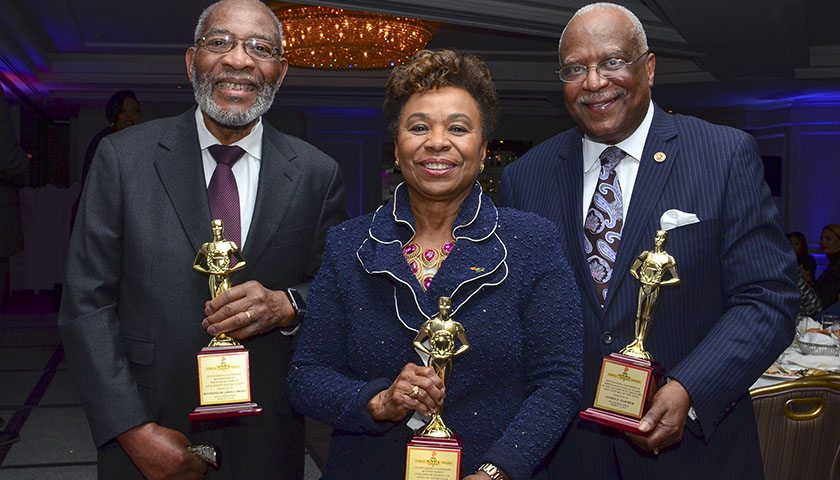
NNPA TORCH AWARDS HONOR ICONS DURING BLACK PRESS WEEK 2018
By Stacy M. Brown (NNPA Newswire Contributor)
Three icons of their respective industries were honored at the National Newspaper Publishers Association’s annual Torch Awards dinner at The Dupont Circle Hotel in Washington, D.C.
Rep. Barbara Lee (D-Calif.), James Farmer of General Motors, and Rev. Dr. Amos C. Brown, a student of Dr. Martin Luther King Jr. and pastor of the Third Baptist Church of San Francisco took home the coveted trophies which are bestowed upon those who demonstrate excellence in their chosen profession or endeavor.
This year’s honorees join a legacy of high-achieving, community-serving African Americans.
“The San Francisco Sun Reporter gave me a voice,” said Lee, as she accepted her award from NNPA National Chair Dorothy Leavell, NNPA President Dr. Benjamin F. Chavis, Jr., and NNPA Foundation Chair Amelia Ashley-Ward, the publisher of the Sun Reporter.
Lee called Ashley-Ward, the publisher of the Sun Reporter, “truly a treasure,” before tearing into a recent secret FBI report that identified some activists in the Black community as “Black Identity Extremists.”
Farmer, whom Chavis praised as one of the most active advocates of the Black Press, completed more than 50 years of dedicated service to “not only his profession, but to the many organizations he served,” Chavis said.
A 1967 graduate of Central State University in Ohio, Farmer entered the automotive industry that year at Airtemp Division, Chrysler Corporation, as an advertising clerk, according to his biography.
There, he began a relationship with the only Black newspaper in Dayton, Ohio, the Dayton Black Express newspaper. After 10 years with Chrysler, Farmer took a position at General Motors where he continued to advocate and support the Black Press—a relationship that continues today.
Farmer said he appreciated the honor and will cherish it.
“This is a group that’s really in my heart,” he said of the Black Press. “If I gave up on the NNPA, I know corporate America could too.”
Brown, who also serves as president of the San Francisco branch of the NAACP and was only one of eight students who took the only college class ever taught by King, said the Black Press has and remains vital in America.
“Again, and again, you have heard from this ‘Dream Team’…this five-star [leadership team],” Brown said of Chavis, Leavell, Ashley-Ward and the leadership of the Black Press. “What African American leaders ought to be about in this nation. You have the chemistry to relate to all people around the word with compassion and courage and I hope you will keep this ‘Dream Team’ intact.”
The ceremony included remarks from Houston Forward Times Publisher and NNPA Vice Chair Karen Carter Richards, who said it was important that the Black Press honor its own.
“If we don’t honor our own, who will? Tonight, we are here to honor distinguished individuals in their fields,” Richards said.
Jackson Caesar, the nephew of gospel great Shirley Caesar, performed two solo songs during the awards ceremony while the group, One Vision Band, provided the entertainment.
Dr. Frederick D. Haynes, III, the Senior Pastor of the Friendship-West Baptist Church in Dallas, Texas, served as keynote speaker.
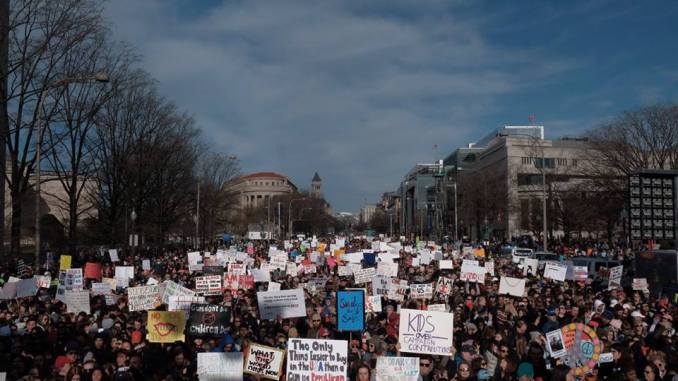
Young Voices Heard at ‘March for Our Lives’ Rally

WASHINGTON — Hundreds of thousands marched in the nation’s capital and across the world to commemorate those killed by gun violence and to demand more effective gun control legislation.
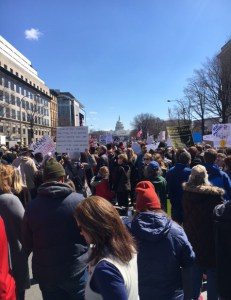
[/media-credit] Thousands of demonstrators participate in the “March for Our Lives” rally in D.C. on March 24 to demand stricter gun control.
The march, titled March for Our Lives, was led by teenagers and survivors of the mass shooting at Marjory Stoneman Douglas High School in Parkland, Florida.
To honor the 17 victims of the February shooting, one of the speakers read their names, “Alyssa Alhadeff, Scott Beigel, Nicholas Dworet, Jaime Guttenberg …” He saved the name of one student, Nicholas Dworet, for last because Saturday would have been his 18th birthday.
The crowd chanted “Never again,” and “Everyday shootings are everyday problems.”
People from across the nation traveled to Washington in support of the cause. One of them was Brianna Richardson, who came from Newtown, Conn., the site of the deadliest public school shooting in America. In 2012, Adam Lanza fatally shot 20 children between 6 and 7 years old, as well as six adult staff members at Sandy Hook Elementary School.
Richardson, whose father is the president of Sandy Hook Volunteer Fire Department, said the incident inspired her to become a nurse.
“I want to help people live happy healthy lives, so that one day we don’t have people who feel so sadly that they have to do these things,” she said. After the tragedy, Richardson began volunteering and pushing for change, as well.
Organizers estimate 800,000 people attended the march in Washington. Numerous celebrities, including Kanye West, Kim Kardashian, Jennifer Hudson, Arianna Grande, George Clooney, Common and Demi Lovato joined the demonstration.
Students and survivors of the Parkland shooting joined with students across the nation and celebrities to share their testimonies on the main stage. There was also a six-minute moment of silence for the time it took to kill the 17 victims at Marjory Stoneman Douglas High School.
One of the speakers on the main stage was the granddaughter of civil rights icon Rev. Martin Luther King Jr.
“I have a dream that enough is enough and that this should be a gun free world, period,” 9-year-old Yolanda Renee King said.
The crowd at the march was very emotional and many were teary-eyed at the remarks made by the speakers.
Amber Kelly, a teen mother, stood in the crowd with her son and expressed the worry she has for her son attending school.
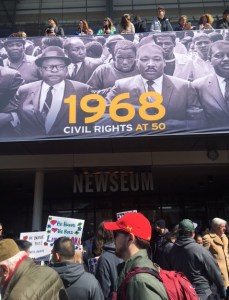
Thousands of demonstrators participate in the “March for Our Lives” rally in D.C. on March 24 to demand stricter gun control.
“I’m more so scared for my son than myself,” Kelly said. “I don’t have the money to send my child to private school or homeschool him. How can I feel comfortable sending my son to school if I know there’s a possibility he could be shot?”
Helena Ristic, 24, is originally from Serbia. She said she decided to join the march to support the young people leading the event and to help end gun violence.
“I think this event shows that even though they’re kids, they can still make change,” Ristic said. “We all want gun violence to end.”
Lots of children were there with their parents. Many held signs and walked alongside their families.
Zachary Hill, 8, walked with his mom and two siblings and was excited he could be a part of this movement.
“I’m really happy we’re making a change for the future,” Hill said.
Aalayah Eastmond, a survivor of the Marjory Stoneman Douglas shooting, urged people not to lose focus on the fact that most gun violence happens in black and Latino neighborhoods.
“It doesn’t only happen in schools,” Eastmond said. “It’s been happening in urban communities forever.”
Naomi Wadler, 11, also took to the main stage with a similar message, ensuring that people of color are not left out of the conversation.
“For far too long, these black girls and women have been just numbers,” said Wadler, a fifth grader who organized a walkout at her elementary school in Alexandria, Va., earlier this month.
“I urge everyone here and everyone who hears my voice to join me in telling the stories that aren’t told, to honor the girls, the women of color who are murdered at disproportionate rates in this nation.”
Shannon Douglas traveled four hours from Virginia Beach, Va., to participate in the demonstration.
“People aren’t taking this seriously,” Douglas said. “The Second Amendment was meant to protect your property and yourself. You don’t need an AK-47 or an SK to protect yourself. A simple handgun can do that.”
Douglas named two of the types of assault rifles protestors want banned. Supporters of gun control are also pushing for the ban of Bump stocks, an accessory that allows semi-automatic weapons to fire much more rapidly.
“We call BS” was another popular chant and the topic of the signs held by the
participants above.
Leaders of the march insisted that the event was a call to action, so volunteers lined the streets to register people to vote so they can elect government officials who will support stronger gun control and remove those who do not.
“Vote them out,” an activist pleaded to the crowd.
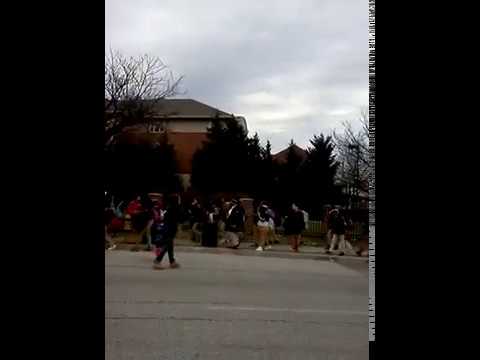
VIDEO: Baltimore Students March Against Gun Violence

Hundreds of students from area high schools walked out of their classrooms today and took to the streets of East Baltimore to protest gun violence.

Students from schools including Paul Laurence Dunbar High School and Baltimore Polytechnic Institute marched down Fayette St., to City Hall in the spirit of the protests that have erupted around the country in wake of the massacre of 17 students and teachers at the Marjory Stoneman Douglas High School in Florida, Feb. 14.
“End the silence, stop gun violence,” was the theme of the protest, demanding safer schools and better gun laws to prevent violent acts.
Baltimore high school students march to City Hall protesting gun violence on March 6. (Video by Sean Yoes)
The post Baltimore Students March Against Gun Violence appeared first on Afro.
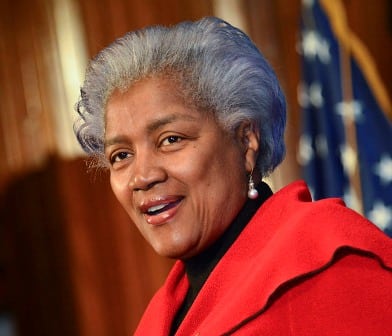
Donna Brazile Keynotes the State of the Black Press in 2018

By Stacy M. Brown, NNPA Newswire
Political analyst and author Donna Brazile delivered a stirring address about the “State of the Black Press in 2018” at the National Press Club in Washington, D.C., capping off the National Newspaper Publishers Association’s (NNPA) annual Black Press Week.
The NNPA is a trade group that represents more than 200 Black-owned media companies operating in the United States. NNPA member publications reach more than 20 million readers in print and online every week.
“I’ve known Donna Brazile for about 40 years and, in 2016, the Democrats couldn’t have selected a better person to lead them,” said Dr. Benjamin F. Chavis, Jr., the president and CEO of the NNPA.
Brazile, the veteran political strategist and former chair of the Democratic National Committee, said that the Black Press is the “pulse of the community.”
“You are carving out stories that the mainstream [media] won’t. You’ve been at the forefront of change, even before change was in vogue,” Brazil said. “That’s why I’ve always supported the Black Press.”
Brazile said she’s walked in and out of many campaign headquarters with a simple, yet critical question for those seeking political office: “Have you engaged the Black Press?”
She recalled working for Michael Dukakis during his failed 1988 presidential campaign against George H.W. Bush.
When she realized the former Massachusetts governor had not spoken with or taking out any advertisements in the Black Press, she stopped working for him.
“I went on strike,” said Brazile, adding that Dukakis told her that he was advised that “it was a waste of money to advertise in the Black Press.”
“I said, ‘Oh, you’ve won this race? You don’t need the Congressional Black Caucus, you don’t need the Black Press?” said Brazile; she convinced Dukakis of the importance of engaging African American-owned media.
“They wound up spending $10,000 with the Black Press…a pittance,” she said. Bush handily defeated Dukakis and Brazile said that the 2016 election proved a repeat of Dukakis’ error. “It’s the same type of thinking that cost Hillary Clinton the election. Had they invested [in advertising in the Black Press]—out of the billions they spent—we would be in this room celebrating.”
Chavis said that if the Democratic Party had listened to Brazile, they could have won.
This year, Chavis said that the NNPA will lead a massive voter registration drive to add 5 million, new Black voters to the rolls.
“This is our payback year!” Chavis said.
Dorothy Leavell, the chairman of the NNPA, said that Brazile spent her career advocating for the Black Press and working to help people understand the value of the Black Press.
“[Donna] has run some of the most influential campaigns, including Reverend Jesse Jackson’s historical presidential campaign and we could never really repay her for the services she’s given to the Black Press,” Leavell said.
The best-selling author of “Hacks: The Inside Story of the Break-Ins and Breakdowns that Put Donald Trump in the White House,” Brazile has devoted her life to working for progressive change, responsible governance, and the advancement of all people in a society that’s fair and equitable, according to her biography.
“This is another moment in our journey for equality for all,” Brazile said. “[The Black Press] should not be marginalized. You’ve been instrumental and vital, and you understand what’s at stake.”
Brazile continued: “You’re making sure untold stories find themselves in your newspapers and this is a moment when our story needs to be told. We’ve come a long way and we need your coverage. We especially need the Black Press, now during this crisis.”

